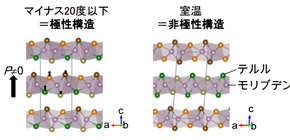
Successful enhancement of thermoelectric conversion rate by suppressing polar lattice distortion
A step toward thermoelectric materials based on a novel principle
Ferroelectrics, which were discovered about 100 years ago, are essential materials for modern electronics. Ferroelectricity is generated by controlling electric polarization (which arises when positive and negative charges in a material are separated) spontaneously generated in a crystal with an external electric field. Electric polarization is not shown in matter with high electrical conductivity, so metals do not become ferroelectric.
Metals that demonstrate the polar structural transition, or “ferroelectric”-like transition, as temperatures decrease have barely been discovered. However, recent theoretical research proposed that when polar structural transition occurs in metals, a novel type of conduction takes place through parity violation, and its experimental verification and development to new electronics have been sought after.
A group of researchers led by Associate Professor SAKAI Hideaki, Graduate School of Science, Osaka University, Associate Professor ISHIWATA Shintaro and former Graduate Student IKEURA Koji, Graduate School of Science, The University of Tokyo, discovered a rare conductive chemical compound which showed a “ferroelectric”-like transition at room temperature and clarified that this transition could be controlled from around 250 K to 0 K by chemical substitution of elements by using the Physical Properties Measurement System and optical spectroscopy.
(Dr. Sakai was an assistant professor of the Graduate School of Science, The University of Tokyo at the time of this research.)
This group synthesized 1T'-MoTe 2 single crystals via a chemical vapor transport technique and, in cooperation with RIKEN Center for Emergent Matter Science, precisely determined crystal structures at low temperatures by structural analysis using x-ray diffraction and measurements of optical second-harmonic generation (SHG). As a result, it was revealed that there is a “ferroelectric”-like polar structure at low temperatures.
Furthermore, this group discovered that when “ferroelectric”-like transition was suppressed to low temperatures by substitution of some elements, thermoelectric efficiency significantly increased. This behavior cannot be reproduced by theoretical calculations, which take only band structures into account, so these results suggest that crystal lattice fluctuation or phase segregation in crystal structure due to a “ferroelectric”-like distortion may give a significant influence on metal properties.
This group’s achievements will lead to the development of innovative electronic materials by controlling polar structure. They also hold promise for applications to innovative thermoelectric technology based on this mechanism.
Abstract
Ferroelectrics with spontaneous electric polarization play an essential role in today’s device engineering, such as capacitors and memories. Their physical properties are further enriched by suppressing the long-range polar order, as exemplified by quantum paraelectrics with giant piezoelectric and dielectric responses at low temperatures. Likewise in metals, a polar lattice distortion has been theoretically predicted to give rise to various unusual physical properties. However, to date, a “ferroelectric”-like transition in metals has seldom been controlled, and hence, its possible impacts on transport phenomena remain unexplored. We report the discovery of anomalous enhancement of thermopower near the critical region between the polar and nonpolar metallic phases in 1T′-Mo 1−x Nb x Te 2 with a chemically tunable polar transition. It is unveiled from the first-principles calculations and magnetotransport measurements that charge transport with a strongly energy-dependent scattering rate critically evolves toward the boundary to the nonpolar phase, resulting in large cryogenic thermopower. Such a significant influence of the structural instability on transport phenomena might arise from the fluctuating or heterogeneous polar metallic states, which would pave a novel route to improving thermoelectric efficiency.
Figure 1
Figure 2
To learn more about this research, please view the full research report entitled “ Critical enhancement of thermopower in a chemically tuned polar semimetal MoTe 2 n ” at this page of the Science Advances website.
Related link
- Hanasaki Laboratory, Graduate School of Science, Osaka University (link in Japanese)
